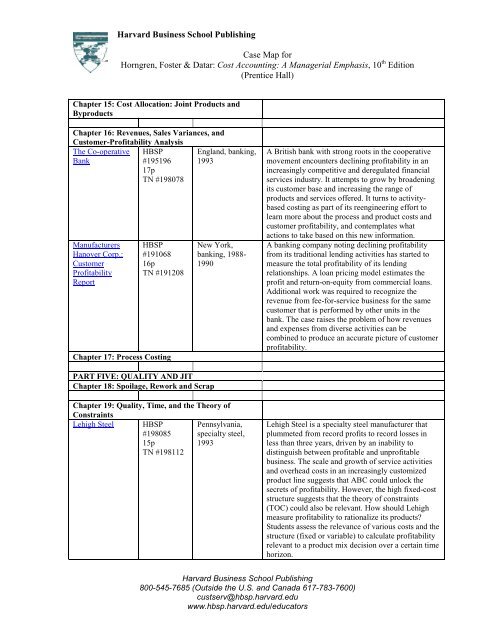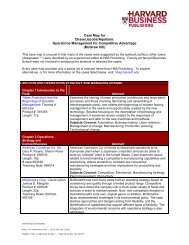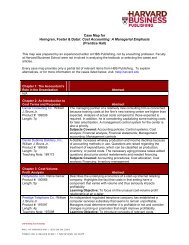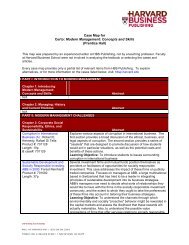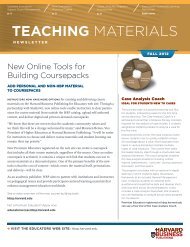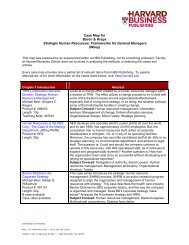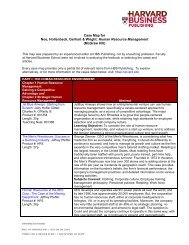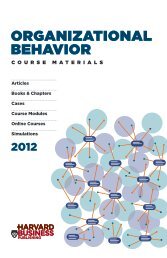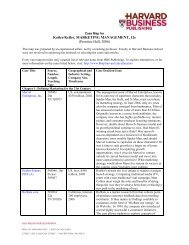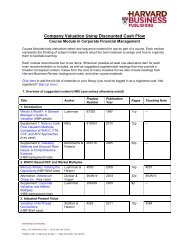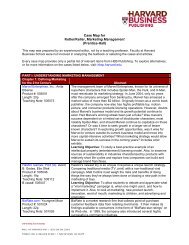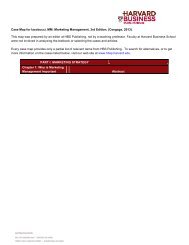Request for Information - Harvard Business School Press
Request for Information - Harvard Business School Press
Request for Information - Harvard Business School Press
You also want an ePaper? Increase the reach of your titles
YUMPU automatically turns print PDFs into web optimized ePapers that Google loves.
<strong>Harvard</strong> <strong>Business</strong> <strong>School</strong> Publishing<br />
Case Map <strong>for</strong><br />
Horngren, Foster & Datar: Cost Accounting: A Managerial Emphasis, 10 th Edition<br />
(Prentice Hall)<br />
Chapter 15: Cost Allocation: Joint Products and<br />
Byproducts<br />
Chapter 16: Revenues, Sales Variances, and<br />
Customer-Profitability Analysis<br />
The Co-operative HBSP England, banking,<br />
Bank<br />
#195196<br />
17p<br />
TN #198078<br />
1993<br />
Manufacturers<br />
Hanover Corp.:<br />
Customer<br />
Profitability<br />
Report<br />
HBSP<br />
#191068<br />
16p<br />
TN #191208<br />
Chapter 17: Process Costing<br />
PART FIVE: QUALITY AND JIT<br />
Chapter 18: Spoilage, Rework and Scrap<br />
New York,<br />
banking, 1988-<br />
1990<br />
Chapter 19: Quality, Time, and the Theory of<br />
Constraints<br />
Lehigh Steel HBSP<br />
#198085<br />
15p<br />
TN #198112<br />
Pennsylvania,<br />
specialty steel,<br />
1993<br />
A British bank with strong roots in the cooperative<br />
movement encounters declining profitability in an<br />
increasingly competitive and deregulated financial<br />
services industry. It attempts to grow by broadening<br />
its customer base and increasing the range of<br />
products and services offered. It turns to activitybased<br />
costing as part of its reengineering ef<strong>for</strong>t to<br />
learn more about the process and product costs and<br />
customer profitability, and contemplates what<br />
actions to take based on this new in<strong>for</strong>mation.<br />
A banking company noting declining profitability<br />
from its traditional lending activities has started to<br />
measure the total profitability of its lending<br />
relationships. A loan pricing model estimates the<br />
profit and return-on-equity from commercial loans.<br />
Additional work was required to recognize the<br />
revenue from fee-<strong>for</strong>-service business <strong>for</strong> the same<br />
customer that is per<strong>for</strong>med by other units in the<br />
bank. The case raises the problem of how revenues<br />
and expenses from diverse activities can be<br />
combined to produce an accurate picture of customer<br />
profitability.<br />
Lehigh Steel is a specialty steel manufacturer that<br />
plummeted from record profits to record losses in<br />
less than three years, driven by an inability to<br />
distinguish between profitable and unprofitable<br />
business. The scale and growth of service activities<br />
and overhead costs in an increasingly customized<br />
product line suggests that ABC could unlock the<br />
secrets of profitability. However, the high fixed-cost<br />
structure suggests that the theory of constraints<br />
(TOC) could also be relevant. How should Lehigh<br />
measure profitability to rationalize its products?<br />
Students assess the relevance of various costs and the<br />
structure (fixed or variable) to calculate profitability<br />
relevant to a product mix decision over a certain time<br />
horizon.<br />
<strong>Harvard</strong> <strong>Business</strong> <strong>School</strong> Publishing<br />
800-545-7685 (Outside the U.S. and Canada 617-783-7600)<br />
custserv@hbsp.harvard.edu<br />
www.hbsp.harvard.edu/educators


